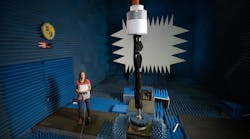Defense security and agility depend on continued miniaturization of electronic systems and three-dimensional (3D) printing provides the means to form smaller circuit assemblies and even antennas. Scientists at the U.S. Naval Research Laboratory (NRL) recently produced miniaturized radar antennas and arrays from computer-aided-design (CAD) models and 3D printing techniques as a faster alternative to designing and developing radar antennas. The antennas and arrays are also a fraction of the weight of existing components, offering naval system designers opportunities to employ the antennas in a wider variety of applications.
NRL electrical engineer Anna Stumme explains that the miniaturization and light weight result as a departure from the machining of solid metals during traditional antenna production processes and using composite materials in the 3D additive manufacturing methods: “3D printing is a way to produce rapid prototypes and get through multiple design iterations very quickly, with minimal cost. The light weight of the printed parts also allows us to take technology to new applications, where the heavy weight of solid metal parts used to restrict us.” Stumme, who won a student paper contest at the 2019 Antenna Application Symposium for a report comparing 3D printed parts with traditionally manufactured parts, said that the fast fabrication times make it possible to investigate many different versions of a design: “We are not trying to say that we need to 3D-print everything and put it on a ship because that is not realistic. We don’t necessarily know how it would hold up in that environment. For us, it is a way to test more design iterations in a short amount of time.”
Stumme (see figure) works closely with Nick Charipar, head of NRL’s Applied Materials and Systems Section which prototypes parts for NRL’s Radar Division. With 3D printing, parts are typically printed with lightweight nylon and then electroplated with conductive metals to achieve electrical performance. As Charipar notes, the smoothness of the conductive electroplating is critical to the success of high-frequency, 3D-printed parts: “Surface roughness is important for waveguides and antennas because it can cause scattering losses and result in a less efficient antenna. Stumme and colleagues are currently at work on a cylindrical array antenna capable of 360° coverage for a surveillance radar. The capability to produce smaller, lighter microwave antennas is anticipated to have great impact on the development of radar-equipped smaller sea vessels, such as unmanned surface vessels (USVs).
